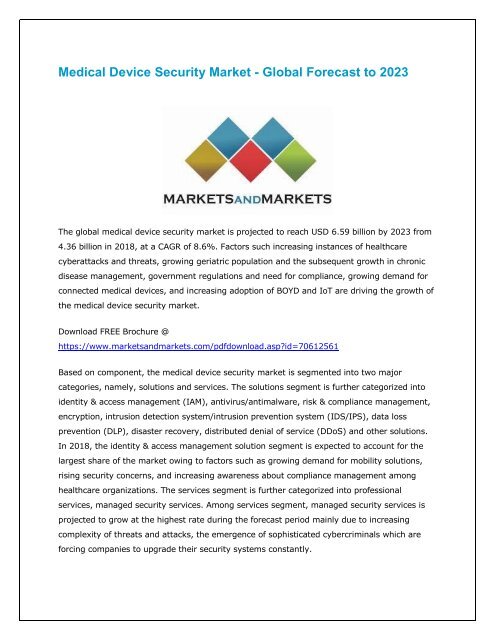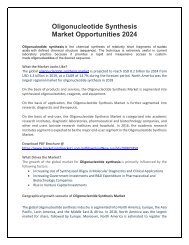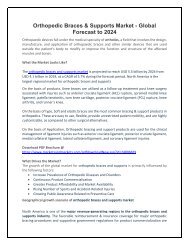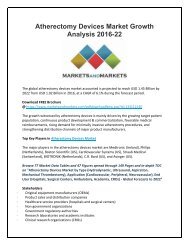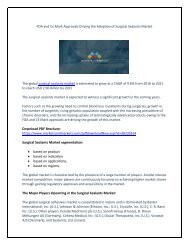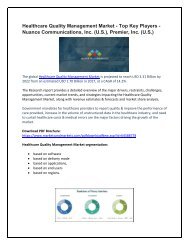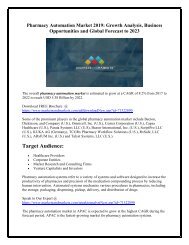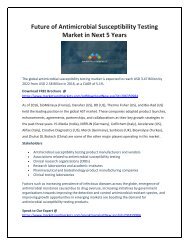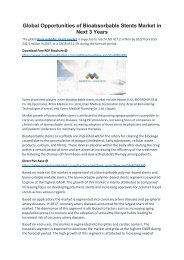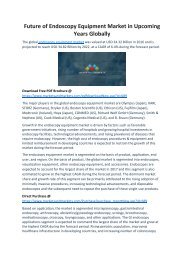Medical Device Security Market - Global Forecast to 2023
The global medical device security market is projected to reach USD 6.59 billion by 2023 from 4.36 billion in 2018, at a CAGR of 8.6%. Factors such increasing instances of healthcare cyberattacks and threats, growing geriatric population and the subsequent growth in chronic disease management, government regulations and need for compliance, growing demand for connected medical devices, and increasing adoption of BOYD and IoT are driving the growth of the medical device security market.
The global medical device security market is projected to reach USD 6.59 billion by 2023 from 4.36 billion in 2018, at a CAGR of 8.6%. Factors such increasing instances of healthcare cyberattacks and threats, growing geriatric population and the subsequent growth in chronic disease management, government regulations and need for compliance, growing demand for connected medical devices, and increasing adoption of BOYD and IoT are driving the growth of the medical device security market.
Create successful ePaper yourself
Turn your PDF publications into a flip-book with our unique Google optimized e-Paper software.
<strong>Medical</strong> <strong>Device</strong> <strong>Security</strong> <strong>Market</strong> - <strong>Global</strong> <strong>Forecast</strong> <strong>to</strong> <strong>2023</strong><br />
The global medical device security market is projected <strong>to</strong> reach USD 6.59 billion by <strong>2023</strong> from<br />
4.36 billion in 2018, at a CAGR of 8.6%. Fac<strong>to</strong>rs such increasing instances of healthcare<br />
cyberattacks and threats, growing geriatric population and the subsequent growth in chronic<br />
disease management, government regulations and need for compliance, growing demand for<br />
connected medical devices, and increasing adoption of BOYD and IoT are driving the growth of<br />
the medical device security market.<br />
Download FREE Brochure @<br />
https://www.marketsandmarkets.com/pdfdownload.asp?id=70612561<br />
Based on component, the medical device security market is segmented in<strong>to</strong> two major<br />
categories, namely, solutions and services. The solutions segment is further categorized in<strong>to</strong><br />
identity & access management (IAM), antivirus/antimalware, risk & compliance management,<br />
encryption, intrusion detection system/intrusion prevention system (IDS/IPS), data loss<br />
prevention (DLP), disaster recovery, distributed denial of service (DDoS) and other solutions.<br />
In 2018, the identity & access management solution segment is expected <strong>to</strong> account for the<br />
largest share of the market owing <strong>to</strong> fac<strong>to</strong>rs such as growing demand for mobility solutions,<br />
rising security concerns, and increasing awareness about compliance management among<br />
healthcare organizations. The services segment is further categorized in<strong>to</strong> professional<br />
services, managed security services. Among services segment, managed security services is<br />
projected <strong>to</strong> grow at the highest rate during the forecast period mainly due <strong>to</strong> increasing<br />
complexity of threats and attacks, the emergence of sophisticated cybercriminals which are<br />
forcing companies <strong>to</strong> upgrade their security systems constantly.
Based on type, the medical device security market is broadly divided in<strong>to</strong> application security,<br />
endpoint security, network security, cloud security, and other security types (email, web, and<br />
database security). The application security segment is expected <strong>to</strong> register the highest CAGR<br />
during the forecast period mainly due <strong>to</strong> fac<strong>to</strong>rs such as proliferation of connected medical<br />
devices and mobile devices, growing usage of web and mobile healthcare applications for<br />
remote patient moni<strong>to</strong>ring and also the increasing demand for medical applications for<br />
physician use.<br />
Based on device type, the medical device security market is segmented in<strong>to</strong> hospital medical<br />
devices, internally embedded medical devices, and wearable and external medical devices.<br />
Wearable and external medical devices are poised <strong>to</strong> be the fastest-growing segment during<br />
the forecast period. This growth is attributed <strong>to</strong> the demand for home healthcare owing <strong>to</strong> the<br />
high and rising prevalence of chronic diseases and the growing need <strong>to</strong> reduce overall<br />
healthcare costs. These fac<strong>to</strong>rs are increasing the demand and uptake of wearable and<br />
external medical devices for remote patient moni<strong>to</strong>ring.<br />
Based on end user, the medical device security market is segmented in<strong>to</strong> healthcare providers,<br />
medical device manufacturers, and healthcare payers. The healthcare providers segment is<br />
expected <strong>to</strong> account for the largest share of the medical device security market in 2018. The<br />
large share of this segment is mainly due <strong>to</strong> the high demand for connected networked medical<br />
devices among healthcare providers owing <strong>to</strong> the various benefits offered by these devices.<br />
Asia Pacific is expected <strong>to</strong> grow at the highest CAGR during the forecast period. The growth of<br />
this market is attributed <strong>to</strong> fac<strong>to</strong>rs such as increasing adoption of connected medical devices,<br />
improving healthcare infrastructure, increasing awareness about security of patient health<br />
information (PHI), and growing awareness about medical device security solutions due <strong>to</strong> the<br />
increasing number of cyberattacks in healthcare organizations. Several market players<br />
expanded their presence in Asia Pacific countries. In this regard, in February 2015, Microsoft<br />
launched the Cybercrime Satellite Center <strong>to</strong> develop cybersecurity solutions in Singapore and<br />
other parts of APAC. This center is expected <strong>to</strong> support all major Southeast Asian countries as<br />
well as Australia, India, Korea, and New Zealand. Also in April 2015, Symantec expanded its<br />
Incident Response Services in North America, the UK, and some parts of APAC. This will enable<br />
the company <strong>to</strong> proactively address security needs and enable continual security improvement<br />
and overall medical device security.
To Know More @ https://www.marketsandmarkets.com/<strong>Market</strong>-Reports/medical-devicesecurity-market-70612561.html


